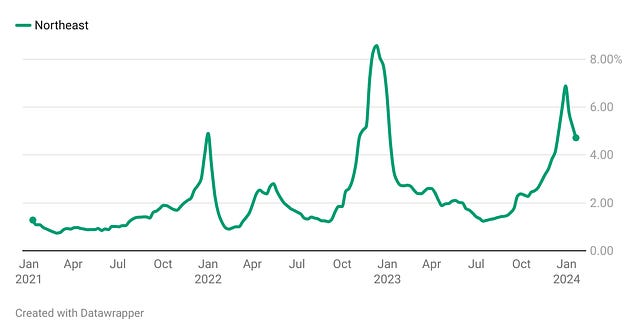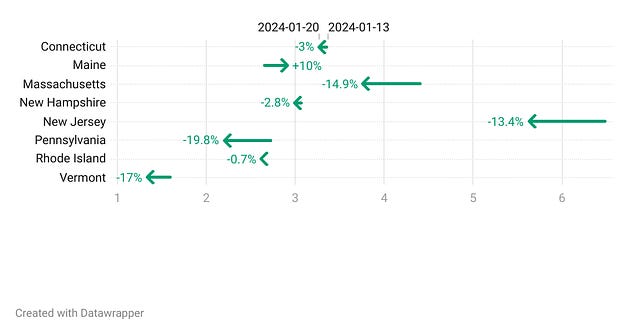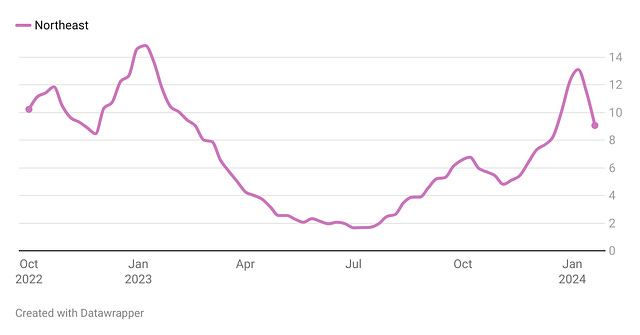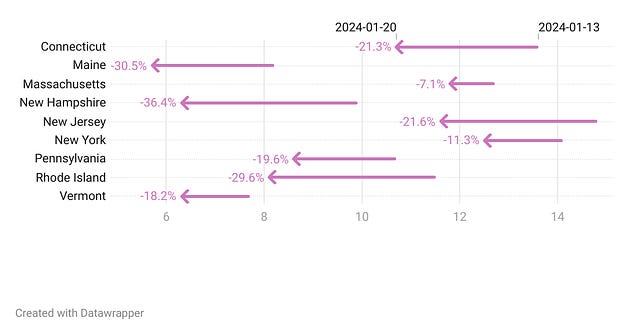Hits: 79
Welcome to the Northeast edition of Outbreak Outlook! It is only available to paid subscribers. If you wish to become a paid subscriber and access region-specific information, please click the Subscribe Now button below. Thanks for reading! -Caitlin
Respiratory Diseases
ILI
The Northeast continues facing moderately elevated flu activity in outpatient settings, though the situation is improving rapidly.
In Maine, influenza-like illness (ILI) has persisted, with a slight increase of 0.3%. Rhode Island and New Hampshire have experienced relatively stable ILI levels over the past week.
On the other hand, several states have seen significant declines in ILI. For instance, Pennsylvania had a decrease of 0.5%, Massachusetts saw a drop of 0.7%, New Jersey experienced a reduction of 0.9%, and Vermont had a decline of 0.3%. These numbers suggest that ILI has peaked in these areas.
Influenza hospitalization rates also retreated across the board last week, with the steepest decreases seen in New Jersey, Massachusetts, and New Hampshire. More moderate yet meaningful drops happened in New York, Connecticut, Pennsylvania, and Maine as well.
Overall the data indicates peak flu activity likely occurred for most Northeastern states based on region-wide declines in hospitalizations. However pockets of stubborn ILI persist, keeping outpatient severity levels still moderately elevated.
COVID-19
The Northeast region experienced a drop in Covid-19 hospitalization rates over the past week, with weekly admissions falling 0.8 per 100,000 population. The decline, from a peak of 13 to 9 per 100k, suggests hospital burdens have started easing across Northeastern states after this season’s wave.
At the state level, decreases were observed in every state over the past week. The most significant declines were in Maine, Rhode Island, and New Hampshire. Additional substantial drops were seen in Vermont, New Jersey, and Massachusetts.
Smaller reductions were reported by Pennsylvania, New York, and Connecticut. With all 9 Northeastern states showing falling hospitalization levels, the region appears to be moving past its peak.
RSV
The Northeast mostly saw decreases in RSV PCR test positivity rates over the past week. Maine saw the most substantial drop at -2.9 percentage points. Other meaningful declines occurred in New Hampshire (-1.0 point), Massachusetts (-1.0 point), and New York (-0.8 points). Smaller decreases happened in Vermont, Connecticut, New Jersey, and Pennsylvania. Rhode Island did not report RSV data.
Stomach Bug
Norovirus activity in the Northeast is remaining steady, with test positivity around 11%. This first quarter of the year tends to be when norovirus circulates widely, so be cautious over the next few months. Remember that hand sanitizer is not particularly effective at preventing norovirus; soap and water is best.
Food recalls
The following foods are being recalled because they are contaminated. Please check your cupboards and throw out any of these items:
New
- Robitussin Honey CF Max cough syrup products (more info)
Previously reported:
- Brightfarm Spinach and Salad Kits (more info)
- Charcuterie meats sold by Fratelli Beretta and, newly, Busseto (more info)
- Tons of different granola and oatmeal products from Quaker (more info).
- If you have food allergies, you may wish to review these FDA safety alerts and USDA alerts for foods with undeclared allergens.
In other news
- Blastomycocis, a fungal infection mostly commonly associated with the northern Midwest and parts of the Southeast, is now being found more commonly in other regions, including Vermont. Blastomycosis is caused by a fungus that is found in wet soil and decaying organic matter. The illness is challenging to diagnose because its symptoms resemble other respiratory infections, including fever, and body aches. If untreated, can lead to serious illness or death. New research indicates a higher prevalence than previously known. A study examining health insurance claims in Vermont between 2011 and 2020 identified 114 cases, with 30% requiring hospitalization.






